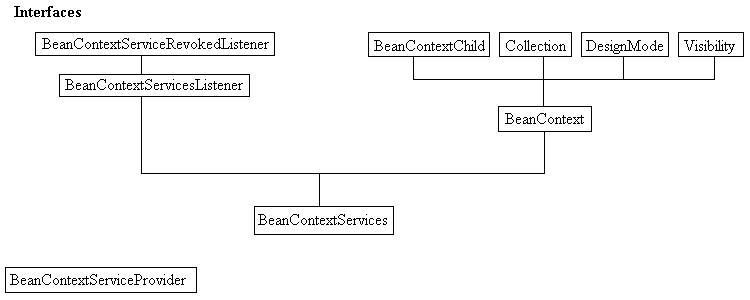Feedback Form
|
|
Start of Tutorial > Start of Trail > Start of Lesson |
Search
Feedback Form |
Purpose
As stated in the specification, the purpose of the Extensible Runtime Containment and Services Protocol is "to introduce the concept of a relationship between a Component and its environment, or Container, wherein a newly instantiated Component is provided with a reference to its Container or Embedding Context. The Container, or Embedding Context not only establishes the hierarchy or logical structure, but it also acts as a service provider that Components may interrogate in order to determine, and subsequently employ, the services provided by their Context."This protocol supports extensible mechanisms that:
- Introduce an abstraction for the environment, or context, in which a JavaBean logically functions during its life-cycle, that is a hierarchy of JavaBeans
- Enable the dynamic addition of arbitrary services to a JavaBean's environment
- Provide a single service discovery mechanism through which JavaBeans may interrogate their environment in order both to ascertain the availability of particular services and to subsequently employ those services.
- Provide better support for JavaBeans that are also Applets.
In English, this means that there now exists a standard mechanism through which Java developers can logically group a set of related JavaBeans into a "context" that the beans can become aware of and/or interact with. This context, or "containing environment", is known as the
BeanContext.There are two distinct types of
BeanContextincluded in this protocol: one which supports membership only (interfacejava.beans.beancontext.BeanContext) and one which supports membership and offers services (interface
java.beans.beancontext.BeanContextServices) to its JavaBeans nested within.
To orient yourself with the classes and interfaces of
java.beans.beancontext, take a minute to look over the following hierarchy diagram. You will notice that the majority of the package is defined as interfaces, which allow for multiple inheritance.Inheritance Diagram of the BeanContext API
The classes and interfaces relevant to theBeanContextAPI are listed in the following diagrams. As you study the diagrams, take note of theBeanContextandBeanContextServicesinterfaces, and that each has its own concrete implementation that you can subclass or instantiate directly (classesjava.beans.beancontext.BeanContextSupportand
java.beans.beancontext.BeanContextServicesSupportrespectively). Also take note of the location of the
java.beans.beancontext.BeanContextChildinterface. This is the interface that allows nested JavaBeans to become aware of their enclosing
BeanContext.





|
|
Start of Tutorial > Start of Trail > Start of Lesson |
Search
Feedback Form |
Copyright 1995-2001 Sun Microsystems, Inc. All rights reserved.